William Upham facts for kids
Quick facts for kids
William Upham
|
|
|---|---|

Restored version of damaged original. Photo by Mathew Brady, circa 1850. Library of Congress Prints and Photographs Division.
|
|
| United States Senator from Vermont |
|
| In office March 4, 1843 – January 14, 1853 |
|
| Preceded by | Samuel C. Crafts |
| Succeeded by | Samuel S. Phelps |
| Member of the Vermont House of Representatives from Montpelier | |
| In office 1830–1831 |
|
| Preceded by | Naum Kelton |
| Succeeded by | Azel Spaulding |
| In office 1827–1829 |
|
| Preceded by | Arunah Waterman |
| Succeeded by | Naum Kelton |
| State's Attorney of Washington County, Vermont | |
| In office 1829–1830 |
|
| Preceded by | Denison Smith |
| Succeeded by | Azel Spaulding |
| Personal details | |
| Born | August 5, 1792 Leicester, Massachusetts, U.S. |
| Died | January 14, 1853 (aged 60) Washington, D.C., U.S. |
| Resting place | Congressional Cemetery, Washington, D.C. |
| Political party | National Republican Anti-Masonic Whig |
| Spouse | Sarah Keyes (m. 1814–1853, his death) |
| Children | 4 |
| Education | University of Vermont (attended) |
| Profession | Attorney |
| Signature | |
William Upham (born August 5, 1792 – died January 14, 1853) was an American lawyer and politician. He was born in Leicester, Massachusetts, and later moved to Montpelier, Vermont. Upham is most famous for serving as a United States Senator for Vermont.
When he was 15, William lost his right hand in an accident. This led him to focus on studying law. He became a lawyer in 1811. Upham strongly supported important changes, like the temperance movement (which aimed to reduce alcohol use) and ending slavery. He changed political parties several times as the movement against slavery grew. He was part of the National Republican Party, then the Anti-Masonic Party, and finally the Whig Party.
Upham was a leader in both the Anti-Masonic and Whig parties. He served in the Vermont House of Representatives twice. He also worked as the State's Attorney for Washington County. In 1842, he was elected to the U.S. Senate and served until his death in 1853. As a senator, he was against the Mexican–American War and against allowing slavery to spread to new areas.
Contents
William Upham's Early Life
William Upham was born on August 5, 1792, in Leicester, Massachusetts. His parents were Samuel and Martha Upham. In 1802, his family moved to Montpelier, Vermont. William worked on his family's farm and went to local schools.
When he was 15, William had a serious accident. His right hand was badly hurt in a cider mill, and he lost it. After this, he decided to study for a professional career. He attended Montpelier Academy and learned from private teachers. He also went to the University of Vermont. Later, he studied law with Cyrus Ward and Samuel Prentiss. In 1835, the University of Vermont gave him an honorary Master of Arts degree.
William Upham's Early Career
William Upham became a lawyer in 1811. He started his law practice in Montpelier with Nicholas Baylies. After several years, Upham ran his own law firm. He was a successful lawyer and also helped train other future lawyers.
Upham became active in politics with the National Republican Party. He strongly supported important causes. These included ending slavery and the temperance movement. From 1827 to 1829, he was a member of the Vermont House of Representatives. He also served as the State's Attorney for Washington County from 1829 to 1830. In 1830, he was elected to the Vermont House again, serving until 1831.
In the early 1830s, Upham joined the new Anti-Masonic Party. He was even the president of their state meeting in Vermont in 1832. In 1834, he tried to become a member of the United States House of Representatives. He ran as a candidate for both the Whig and Anti-Masonic parties but did not win. Later, in the mid-1830s, Upham led Vermont's Whig Party. In 1840, he campaigned for William Henry Harrison, who became president.
William Upham as a U.S. Senator
In 1842, Samuel Prentiss left his seat in the U.S. Senate. Samuel C. Crafts was chosen to fill the spot temporarily. William Upham then became the Whig candidate for the full term. He won the election and started serving on March 4, 1843. He was reelected in 1848 and served until his death.
While in the Senate, Upham led two important committees. He was chairman of the Committee on Agriculture. He also led the Committee on Pensions.
Upham was against slavery. He spoke out against the Mexican–American War. He introduced ideas to quickly end the war or have the U.S. leave Mexico. He did not want slavery to spread to new areas. He voted against the Fugitive Slave Act of 1850 and other parts of the Compromise of 1850. He also supported the Wilmot Proviso. This idea would have stopped slavery in any land gained from the Mexican War.
Death and Burial
William Upham became sick in late 1852. He died from smallpox in Washington, D.C. on January 14, 1853. People believed he was contagious, so his funeral was held quickly. His body was not sent back to Vermont. He was buried at Congressional Cemetery in Washington, D.C.
Quotations
- "...Slavery is a crime against humanity and a sore evil in the body politic."
Family Life
In 1814, William Upham married Sarah Keyes. They had five children together. Four of their children lived to adulthood:
- William Keyes Upham (1817–1865)
- Charles Carroll Upham (1819–1868)
- Sarah Sumner (Upham) Langdon (1821–1888)
- Mary Annette Upham (1825–1899), who sadly died in the 1899 Windsor Hotel fire.
See also
- List of United States Congress members who died in office (1790–1899)


